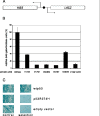CP-31398, a putative p53-stabilizing molecule tested in mammalian cells and in yeast for its effects on p53 transcriptional activity
- PMID: 15548325
- PMCID: PMC534789
- DOI: 10.1186/1477-5751-3-5
CP-31398, a putative p53-stabilizing molecule tested in mammalian cells and in yeast for its effects on p53 transcriptional activity
Abstract
Background: CP-31398 is a small molecule that has been reported to stabilize the DNA-binding core domain of the human tumor suppressor protein p53 in vitro. The compound was also reported to function as a potential anti-cancer drug by rescuing the DNA-binding activity and, consequently, the transcription activation function of mutant p53 protein in mammalian tissue culture cells and in mice.
Results: We performed a series of gene expression experiments to test the activity of CP-31398 in yeast and in human cell cultures. With these cell-based assays, we were unable to detect any specific stimulation of mutant p53 activity by this compound. Concentrations of CP-31398 that were reported to be active in the published work were highly toxic to the human H1299 lung carcinoma and Saos-2 cell lines in our experiments.
Conclusion: In our experiments, the small molecule CP-31398 was unable to reactivate mutant p53 protein. The results of our in vivo experiments are in agreement with the recently published biochemical analysis of CP-31398 showing that this molecule does not bind p53 as previously claimed, but intercalates into DNA.
Figures





Similar articles
-
Characterization of the p53-rescue drug CP-31398 in vitro and in living cells.Oncogene. 2002 Mar 28;21(14):2119-29. doi: 10.1038/sj.onc.1205362. Oncogene. 2002. PMID: 11948395
-
The p53-stabilizing compound, CP-31398, does not enhance chemosensitivity in human melanoma cells.Anticancer Res. 2003 Jan-Feb;23(1A):99-105. Anticancer Res. 2003. PMID: 12680200
-
Reporter gene regulation in Saccharomyces cerevisiae by the human p53 tumor suppressor protein.J Mol Microbiol Biotechnol. 2002 Nov;4(6):539-50. J Mol Microbiol Biotechnol. 2002. PMID: 12432954
-
Reactivation of mutant p53: molecular mechanisms and therapeutic potential.Oncogene. 2007 Apr 2;26(15):2243-54. doi: 10.1038/sj.onc.1210295. Oncogene. 2007. PMID: 17401433 Review.
-
Rescuing the function of mutant p53.Nat Rev Cancer. 2001 Oct;1(1):68-76. doi: 10.1038/35094077. Nat Rev Cancer. 2001. PMID: 11900253 Review.
Cited by
-
Characterization of the new human pleomorphic undifferentiated sarcoma TP53-null cell line mfh-val2.Cytotechnology. 2017 Aug;69(4):539-550. doi: 10.1007/s10616-017-0112-5. Epub 2017 Jul 4. Cytotechnology. 2017. PMID: 28676915 Free PMC article.
-
Virtual screening using covalent docking to find activators for G245S mutant p53.PLoS One. 2018 Sep 7;13(9):e0200769. doi: 10.1371/journal.pone.0200769. eCollection 2018. PLoS One. 2018. PMID: 30192754 Free PMC article.
-
Pharmacological activation of p53 in cancer cells.Curr Pharm Des. 2011;17(6):631-9. doi: 10.2174/138161211795222595. Curr Pharm Des. 2011. PMID: 21391904 Free PMC article. Review.
-
Targeting Oncogenic Mutant p53 for Cancer Therapy.Front Oncol. 2015 Dec 21;5:288. doi: 10.3389/fonc.2015.00288. eCollection 2015. Front Oncol. 2015. PMID: 26732534 Free PMC article. Review.
-
Targeted rescue of a destabilized mutant of p53 by an in silico screened drug.Proc Natl Acad Sci U S A. 2008 Jul 29;105(30):10360-5. doi: 10.1073/pnas.0805326105. Epub 2008 Jul 23. Proc Natl Acad Sci U S A. 2008. PMID: 18650397 Free PMC article.
References
Publication types
MeSH terms
Substances
LinkOut - more resources
Full Text Sources
Other Literature Sources
Research Materials
Miscellaneous

